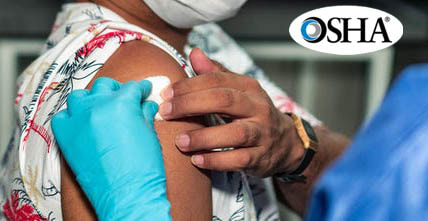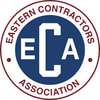OSHA Standard Regarding Vaccine Mandates Released
White Houses Pushes Mandate Date to January 4

On November 4, 2021, OSHA released the anticipated COVID-19 Vaccination and Testing Emergency Temporary Standard (ETS) for Employers With 100 or More Employees, which can be found here and is scheduled to be published in the Federal Register on November 5.
The new COVID-19 Vaccination and Testing Emergency Temporary Standard (ETS) requires employers with 100 or more employees (i.e., “covered employers”) to:
Click here for an OSHA Fact Sheet or go to their website for more information.
The new COVID-19 Vaccination and Testing Emergency Temporary Standard (ETS) requires employers with 100 or more employees (i.e., “covered employers”) to:
- Get Their Employees Vaccinated by JANUARY 4 and Require Unvaccinated Employees to Produce a Negative Test on at Least a Weekly Basis: All covered employers must ensure that their employees have received the necessary shots to be fully vaccinated – either two doses of Pfizer or Moderna, or one dose of Johnson & Johnson – by January 4 (the date had previously been December 8). After that, all covered employers must ensure that any employees who have not received the necessary shots begin producing a verified negative test to their employer on at least a weekly basis, and they must remove from the workplace any employee who receives a positive COVID-19 test or is diagnosed with COVID-19 by a licensed health care provider. The ETS lays out a wide variety of tests that comply with the standard. Given that vaccines are safe, free, and the most effective way for workers to be protected from COVID-19 transmission at work, the ETS does not require employers to provide or pay for tests. Employers may be required to pay for testing because of other laws or collective bargaining agreements.
- Pay Employees for the Time it Takes to Get Vaccinated: All covered employers are required to provide paid time off for their employees to get vaccinated and, if needed, sick leave to recover from side effects experienced that keep them from working.
- Ensure All Unvaccinated Employees are Masked: All covered employers must ensure that unvaccinated employees wear a face mask while in the workplace.
- Other Requirements and Compliance Date: Employers are subject to requirements for reporting and recordkeeping that are spelled out in the detailed OSHA materials available here. NOTE that while the testing requirement for unvaccinated workers will begin after January 4, employers must be in compliance with all other requirements on December 5 (such as providing paid time off for employees to get vaccinated and masking for unvaccinated workers). The Administration is calling on all employers to step up and make these changes as quickly as possible.
- Streamlining Implementation and Setting One Deadline Across Different Vaccination Requirements: The rules released today ensure employers know which requirements apply to which workplaces. Federal contractors may have some workplaces subject to requirements for federal contractors and other workplaces subject to the newly-released COVID-19 Vaccination and Testing ETS. To make it easy for all employers to comply with the requirements, the deadline for the federal contractor vaccination requirement will be aligned with those for the CMS rule and the ETS. Employees falling under the ETS, CMS, or federal contractor rules will need to have their final vaccination dose – either their second dose of Pfizer or Moderna, or a single dose of Johnson & Johnson – by January 4, 2022. This will make it easier for employers to ensure their workforce is vaccinated, safe, and healthy, and ensure that federal contractors implement their requirements on the same timeline as other employers in their industries. And, the newly-released ETS will not be applied to workplaces subject to the federal contractor requirement or CMS rule, so employers will not have to track multiple vaccination requirements for the same employees.
Click here for an OSHA Fact Sheet or go to their website for more information.

